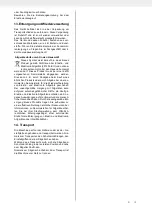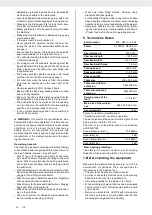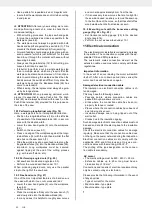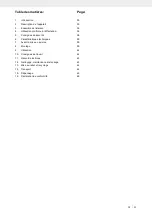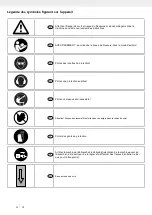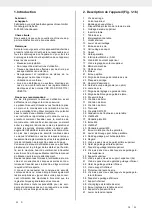
29
GB
• Remove the worn table insert (6) by lifting it up and
out.
• Installation of the new table insert takes place in
reverse order.
8.14 Replacing the saw band (Fig. 1a+1b+16+16.1)
• Set the saw band guide (5) at approx. half height
between the saw table (7) and machine frame (18).
• Undo the cover locking mechanisms (12) and open
the side covers (13).
• Remove the screw M6x35 (36) with two washers
(37) and the nut (38) of the table. (Fig. 3)
• Relieve the Bandsaw blade (26) tension by turning
the clamping screw (1) anti-clockwise.
• If necessary, release the quick-release lever (61).
• Remove the Bandsaw blade (26) from the saw band
rollers (2+9) and through the slot in the saw table (7).
• Place the new Bandsaw blade (26) centrally on
both saw band rollers (2+9). The teeth of the Band-
saw blade (26) must point downwards in the direc-
tion of the saw table (Fig. 6).
• Set quick-release lever (61) to position A (tension).
The saw band must not be fully tensioned yet.
• Tension the Bandsaw blade (26) (see 8.6)
• Close the side cover (13) again.
• Mount the M6x35 bolt (36) to the table with two
washers (37) and the nut (38). (Fig. 3)
8.15 Extraction nozzle (Fig. 1b)
The band saw is equipped with an extraction nozzle
(24) Ø 40 mm for chips.
Only operate the device with a suitable extraction
system. Check and clean the suction channels at
regular intervals.
8.16 Mitre gauge (optional) (25) (Fig. 23)
• Slide lateral stop (25) into a groove (A) in the saw
bench.
• Release the grip screw (E).
• Turn the lateral stop (C) until the desired angular
dimension has been set. The arrow (F) on the lat-
eral stop indicates the set angle.
• Retighten the grip screw (E).
• The stop rail (B) can be slid against the lateral
stop (C). To do so, loosen the knurled screws (D)
and slide the stop rail (B) into the desired position.
Tighten the knurled screws (D) again
m
ATTENTION!
Do not slide the stop rail (B) too far
in the direction of the saw blade.
m
ATTENTION!
When working with the machine, all
protective devices and guards must be fitted.
The upper and lower bandwheel is protected by a
fixed guard and an articulated cover. When opening
the cover, the machine is switched off. Starting is
possible only with closed cover.
9. Operation
9.1 On/Off switch (15) (Fig. 17)
• To turn the machine on, press the green button „I“.
• To turn the machine off again, press the red button „0“.
• The band saw is equipped with an under voltage
switch. With a power failure, the band saw must be
switched back on again.
9.2 Fitting the parallel stop (Fig. 5+18)
• Place the parallel stop (14) on the guide rail (43) to
the left or right of the sawing blade.
•
Press the clamping bar (42) down to fix the parallel
stop (14) in place. The clamping force of the paral-
lel stop can be adjusted at the rear knurled nut (41).
• Make sure that the parallel stop (14) always runs
parallel to the band saw blade (26).
9.3 Angled cuts (Fig. 20)
In order to execute angled cuts parallel to the band
saw blade (26), it is possible to tilt the saw bench (7)
forwards from 0° - 45°.
• Undo locking handle (22) and wing nut (21).
• Tilt saw bench (7) forwards, until the desired angle
is set on the degree scale (35).
• Retighten the locking handle (22) and wing nut (21).
m
ATTENTION!
With a tilted saw table (7), the paral-
lel stop (14) must always be fitted to the right of the
band saw blade (26) in the working direction. This
prevents the workpiece from slipping.
10. Working instructions
The following recommendations are examples of the
safe use of band saws.
The following safe working methods should be seen
as an aid to safety. They cannot be applied suitably
completely or comprehensively to every use. They
cannot treat every possible dangerous condition and
must be interpreted carefully.
• Connect the machine to a suction unit when work-
ing in closed rooms. A suction device which con-
forms with commercial regulations must be used
for suction in commercial areas.
• Loosen the sawband when the machine is not in
operation (e.g. after finishing work). Attach a notice
on the tension of the saw band to the machine for
the next user.
• Collect unused sawbands and store them safely in
a dry place. Check for faults (teeth, cracks) before
use. Do not use faulty sawbands!
• Wear suitable gloves when handling sawbands.
• All protective and safety devices must be securely
mounted on the machine before beginning work.
• Never clean the sawband or the sawband guide
with a hand-held brush or scraper while the saw-
band is running. Resin-covered sawbands impair
working safety and must be cleaned regularly.
• For your own protection, wear protective glasses
and hearing protection. Wear a hairnet if you have
long hair. Roll up loose sleeves over the elbows.
• Always position the sawband guide as near the
workpiece as possible when working.
•
Insure sufficient lighting in the work area and
around the machine.
• Always use the fence for straight cuts to keep the
workpiece from tipping or slipping away.
• When working on narrow workpieces with manual
feed, use the push stick.
• For diagonal cuts, place the saw bench in the appro-
priate position and guide the workpiece on the fence.
• In order to cut dovetail tenons and teeth or wedges,
bring the saw table into the corresponding position
on the angle scale.
• For arced and irregular cuts, push the workpiece
evenly using both hands with the fingers together.
Hold the workpiece with your hands on a safe area.
Содержание 5901501958
Страница 2: ......
Страница 4: ...2 35 21 22 23 4 3 4 1 8 7 4 2 10 5 14 41 42 4 39 8 40 3 23 7 22 21 26 36 37 38 4 4 39 40 ...
Страница 6: ...16 14 60 29 15 6 13 58 59 11 28 5 27 4 12 5 26 7 4 17 15 16 1 A B B 61 ...
Страница 7: ...18 14 42 19 21 20 22 23 25 A B C D E F ...
Страница 47: ...47 D ...
Страница 49: ...49 D ...
Страница 50: ... www scheppach com service scheppach com 49 08223 4002 99 49 08223 4002 58 ...





